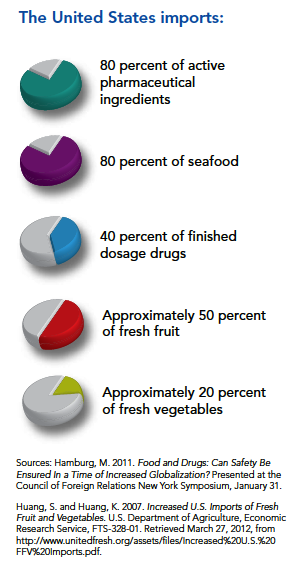
Since this blog post is Part 2 of 4 in a series focusing on how food and nutrition consumption can potentially influence prostate cancer prevention, incidence & progression, treatment, and survivorship, let’s review how the intake of a rainbow of fruits and vegetables mentioned in part 1 of 4 can actually be part of the silver lining in the clouds surrounding this type of cancer diagnosis.
(Double rainbow photo courtesy of Stuart Bran, taken in Rousseau, Dominica)
In Part 1, we got as far as mentioning antioxidants (general and specific) and anti-inflammatory agents, suggesting a general rule of thumb is to aim to eat a minimum of 5 servings of fruits and vegetables/day and preferably 8-10 servings/day coming from very colorful fruits & vegetables. This might work out to be eating 1 or more cups of vegetables with at least 2 meals each day.
Look for darker shades of color within the rainbow of colors (jewel tones) which have higher concentrations of these important substances. One “serving” of fruits & vegetables in this specific context would be equivalent to about 1/2 cup of a cooked/canned fruit or vegetable; 1 cup of raw, leafy greens that are dark/deep green in color; 1/4 cup of a dried fruit or vegetable; or 6 fluid oz of 100% juice/vegetable (NO sugar added) from a fruit or vegetable.
An upcoming post will list a wide variety of these fruits and vegetables as a reminder of some of their potential health benefits and tie into Farmers Markets seasonal availability of them as well.
Please keep in mind that this site only provides infotainment and nothing more–talk with your health care providers about your own unique nutritional status and medical needs accordingly.
Next is 5. Dietary fiber obtained from whole food choices such as fruits and vegetables, beans/legumes/pulses, & whole grains can bind to toxic compounds & carcinogens and allow those toxic compounds to then later be eliminated by the body. For this reason, it is thought that dietary fiber may help to prevent prostate cancer progression.
Speak with your health care practitioners about what level of dietary fiber intake to aim for and remember that it is critical to also consume desirable fluids to maintain GI tract regularity. Anyone used to a much lower fiber intake would need to very gradually build up to a higher fiber intake over a period of time with adequate desirable fluids as allowed in their diet each day.
6. Some desirable cruciferous vegetables include arugula, beet greens, bok choy, broccoli, Brussels sprouts, cabbage, cauliflower, collard greens, horse radish, kale, kohlrabi, mustard greens, radishes, rutabaga, Swiss chard, turnip greens, wasabi, and watercress.
7. Some allium vegetables (which are rich sources of allyl sulfides) include chives, garlic, leeks, onions, and shallots. Some research indicates that maximum benefit may be obtained after peeling and chopping/slicing/crushing fresh garlic, then allowing it to stand for 10-15 minutes prior to cooking it (do NOT roast garlic intact in the peel as heat leads to the inactivation of the valuable enzymatic action of alliinase that is considered to be cancer-fighting).
CAUTION: When it comes to fruit & vegetable intake, if true organic farming methods are not being used, fruits and vegetables can be subject to exposure to pesticides. It is thought that compared to conventionally grown fruits and vegetables, organic options may have lower pesticide residues, lower levels of total pesticides, lower overall pesticide toxicity, and potentially higher levels of vitamins and phytonutrients.
 Many of the fresh fruits & vegetables sold in our supermarkets are actually imported into the USA from other countries and thus it is much harder to be sure of what they were exposed to prior to being imported. A graphic included in the 2012 report Global Engagement from the US FDA notes that it is estimated that approximately 50% of fresh fruit and 20% of fresh vegetables sold in the USA are imported.
Many of the fresh fruits & vegetables sold in our supermarkets are actually imported into the USA from other countries and thus it is much harder to be sure of what they were exposed to prior to being imported. A graphic included in the 2012 report Global Engagement from the US FDA notes that it is estimated that approximately 50% of fresh fruit and 20% of fresh vegetables sold in the USA are imported.
Even if you buy organic produce, be sure to remember to thoroughly wash fruits and vegetables before consuming them. This is especially true for apples, bell peppers, celery, cherries, grapes, nectarines, peaches, pears, potatoes, raspberries, spinach, strawberries and is based upon data from the USDA Pesticide Data Program Summary (latest available USDA data on the 12 fruits and vegetables to watch the most as of the date of this write-up was for year 2009).
In part 3 of 4 of this blog series of posts, some additional details for a number of the following food and nutrition focus items will be mentioned:
- Dairy, Calcium, and Vitamin D intake
- Fats in general and specific fatty acids
- Flax seed (lignans source) supplementation
- Glutamine, Prebiotics & Probiotics in instances of GI complications
- Lean meat and cooking methods
- Lycopene
In Part 4 of 4 of this blog series of posts, we’ll include some additional information on:
- Medicinal Mushrooms
- Modified citrus pectin
- Polyphenols (including curcumin, epigallocatechin gallate, and resveratrol)
- Pomegranates and its ellagitannins content
- Selenium & potential Vitamin E synergistic actions
- Simple sugars and IGF response
- Soy (and other lean protein sources, including legumes)
- Soy and isoflavone intake, & potential Green Tea Catechins synergistic actions
- Turmeric and its curcumin content; also role of piperine found in black pepper on curcumin absorption
- Vitamin E
For hotlinks to potential resource sites, please see the Part 1 blog post in this series.
We sincerely hope you find this series to be informative and helpful and please remember to discuss specifics about what they recommend for your individual health status with your health care practitioners.

